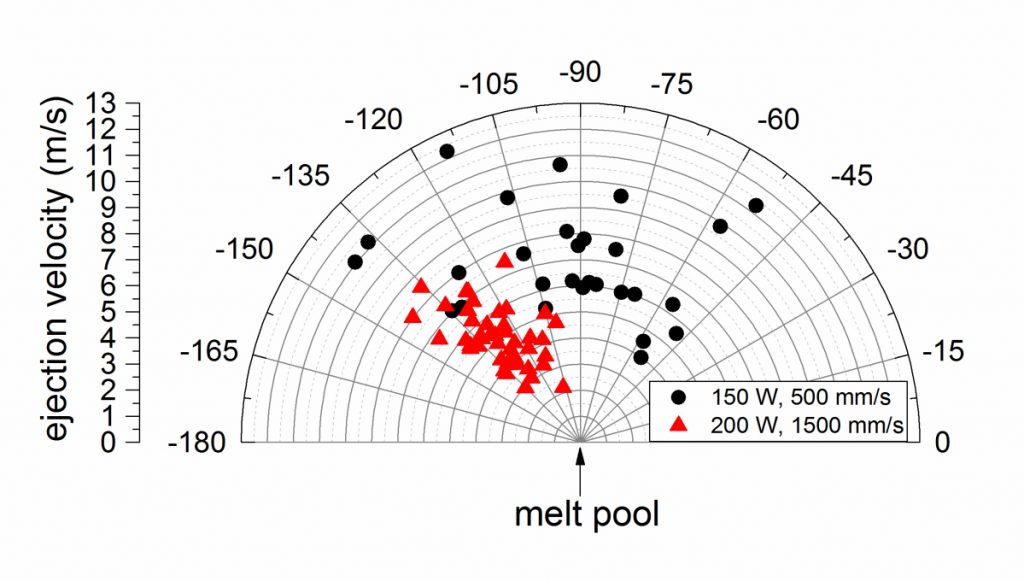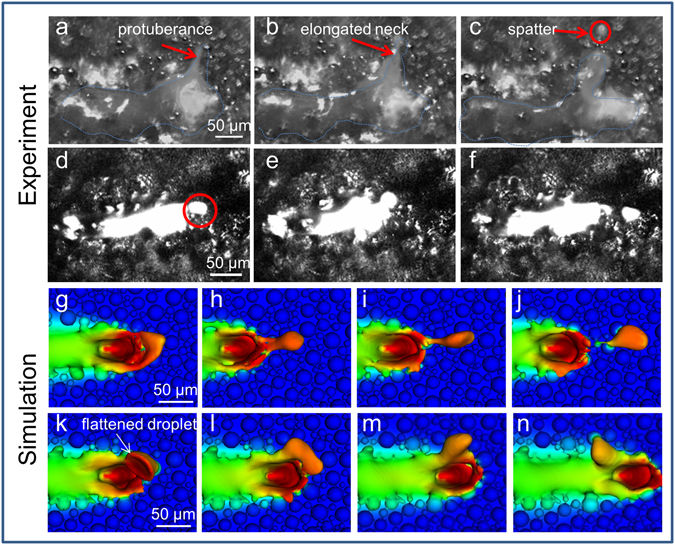Lawrence Livermore National Laboratory (LLNL) researchers have released a report on the behaviour of metal particles inside powder bed fusion (PBF) 3D printers.
The study has succeeded in recording images of the molten metal pool inside such machines, identifying the cause of the “spatter” effect that creates imperfections in a finished metal part.
Readers of 3D Printing Industry will already be familiar with the work and this discovery is an update of ongoing research at the lab and results published in July last year.
Speaking to 3D Printing Industry about the earlier research GE’s Bill Carter explained how a custom built research platform was used to capture the 500,000 frames per second necessary.
The remarkable images show how laser scanning displaces metal powder. This area of powder displacement is referred to as the denudation zone (DZ).
Writing in August 2016’s Acta Materialia a research team found, “Flow is induced by the intensive evaporation that occurs within the laser spot and pressure drop inside the associated vapor jet due to the Bernoulli effect”.
First published in 1738, Bernoulli’s principles on fluid dynamics describe how flow speed and pressure are related. The principles are used in aerodynamic design to ensure F1 racing cars remain grounded and airplanes aloft.
From YouTube: “This video depicts the metal powder bed fusion (AM) process with titanium powder in an air atmosphere. Normally, ‘spatter’ or sparks would result in droplets flying around, but in an air environment, the droplets explode like fireworks.” Clip via Lawrence Livermore National Laboratory
A phenomenon of fireworks
Spatter is a firework-like phenomenon that occurs inside the build chamber of metal 3D printers.
When a laser moves over a bed of metal powder it creates a melt pool and, due to the spatter effect, unmelted particles are dragged into this pool behind the laser.
As the laser has already passed over this path, the semi-sintered particles in the melt pool no longer receive the energy required to melt fully, causing weaknesses in an end part.

PBF machines work on the same basic principle as welding, and so it was originally assumed that spatter was caused by the same laser induced recoil pressure.
The latest images from LLNL prove that the phenomenon is caused by an induced gas flow, added to the build chamber to create an ambient print atmosphere.
Challenging perceptions
High-speed images of the melt pool were captured by the LLNL team using three kinds of cameras. One sensor used in the experiments is capable of capturing up images at up to 10 million frames per second.
High-speed imaging of particle behaviour in the melt pool. Clip via Supplementary information, Scientific Reports
Sonny Ly, an LLNL physicist and lead author of the research, describes what can be seen in the recordings, “We imaged right at the melt pool and you could see particles ejected right from the pool due to recoil, but a majority of particles are swept away and entrained by the gas flow.”
Ly continues, “The entrained particles can go back into the laser beam and are melted, leading to a more dominant form of spatter.”
According to Gabe Guss, LLNL engineer and co-author of the study, “It turns out only about 15 percent of the ejections of molten particles are caused by splashing in the melt pool, which was the assumed mechanism — the rest is primarily cold particles passing through the laser beam above the melt pool and some other factors.”

The spatter solution?
As the cameras cannot show detail of particle behaviour below the melt pool, computer simulations were also used creating a more accurate picture of the powder bed.
Saad Khairallah, the LLNL computational engineer/physicist responsible for the digital models, explains, “The simulations showed a difference in the morphology of the melt pool beneath the laser spot, which allowed us to interpret the experimental observations.”
In an earlier interview with 3D Printing Industry, Shawn Moylan from NIST explained the challenges associated with recording a laser “moving roughly a meter per second and it’s only a 100 or so micrometers in size”.

The information garnered from the study should help researchers establish a baseline that can be used to cancel out the spatter effect in PBF processes. This in turn could lead to more widespread adoption of the technology across the manufacturing industry.
Further reading
Melt pool metrology is one of the key areas of additive research in the industry today.
Writing for 3D Printing Industry in March 2017, Alban Leadri gives a two part summary of the current challenges to metal additive processes.
The U.S. National Institute of Standards and Technology (NIST) has also released studies on the topic.
A full paper on the study discussed in this article is accessible online in the journal Scientific Reports. It is co-authored by Sonny Ly, Alexander M. Rubenchik, Saad A. Khairallah, Gabe Guss and Manyalibo J. Matthews.
For all the latest 3D printing research updates and more, sign up to the 3D Printing Industry newsletter and follow us on Twitter.
Our 3D printing jobs site is open now.
Featured image: Advanced imaging of melt pool metrology in metal powder bed fusion has been captured at LLNL. Photo via Lawrence Livermore National Laboratory



